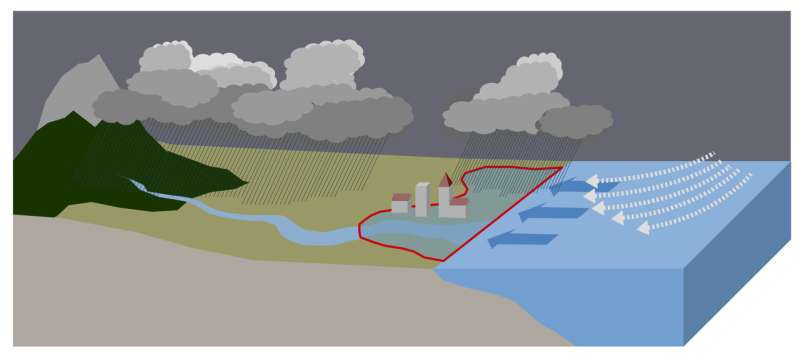Compound flooding caused by the interaction between storm surge and heavy rainfall. A moderate storm surge can obstruct the gravity-feed drainage of pluvial or fluvial water into the sea. Or, rainfall on top of a storm surge inundated area can worsen the overall flooding. Credit: Douglas Maraun
A team of researchers from across Europe has found via simulations that parts of the U.K. and northern Europe are likely to see more compound flooding events in the next century due to global warming. In their paper published in the journal Science Advances, the group describes building their simulations and what they showed.
Compound flooding events occur when two or more weather events that would lead to flooding on their own happen at the same time in the same place. In this new effort, the researchers focused on low-pressure systems and excess rain events. Low-pressure events over bodies of water such as the English Channel can push water inland—such storm surges quite often result in flooding coastal areas. Storms that dump more than normal amounts of rain on a given area over a short period of time can also lead to flooding. When you put the two together in the same place at the same time, very serious flooding can occur. The researchers point out the havoc that resulted from two compound flooding events in recent years—one on the Avon in Bristol in 2014, and the other in Ravenna in Italy in 2015.
The researchers note that currently, it is far more common for compound flooding events to happen in southern parts of Europe as opposed to the North—mostly around the Mediterranean Sea. But they warn that the situation is likely to change over the next century as the planet continues to warm. They believe that some parts of the U.K. and areas near the Black Sea are likely to see more of such events as rain patterns change due to the impact of global warming.
The work involved building computer weather models for all of Europe using current conditions, and then adjusting parameters to see how things might change over the next 100 years. In this case, the main parameters were temperature and ocean level rise. The rise in temperature is expected to bring more rainfall to many parts of Europe and more storm surges to coastal areas. The researchers report that their simulations showed a higher incidence of compound flooding events along the western coast of the U.K., parts of northern France and areas along the North and Black Seas.
More information: E. Bevacqua et al. Higher probability of compound flooding from precipitation and storm surge in Europe under anthropogenic climate change, Science Advances (2019). DOI: 10.1126/sciadv.aaw5531
Journal information: Science Advances
© 2019 Science X Network
























